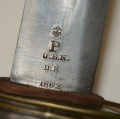site search
online catalog
U.S. CIVIL WAR NAVY CUTLASS AND SCABBARD

$1,100.00 SOLD
Quantity Available: None
Item Code: 1142-23
These are still referred to as the Model 1860 for convenience, though recent scholarship dates them firmly as 1861. This one is in great condition and complete with scabbard. The brass cup hilt is free of dents. The black leather-wrapped grip is complete, with good color and finish. It lacks the brass wire binding as virtually all of these do, the Navy having apparently having ordered its removal from the formation of verdigris, etc. The brass guard and pommel have a nice medium tone.
The blade bears the Ames Manufacturing Company “scroll” style blade address on the reverse and the obverse bears a “U.S.N. / D.R. / 1862” inspection, acceptance, and date stamp. Over this is a U.S. Navy anchor and “P” stamp, which indicate the cutlass was retained in the postwar U.S. navy. Indeed, some sources indicate these were occasionally found in shipboard stores through World War One. The scabbard is the standard Civil War pattern with a brass button on the upper obverse to secure it in the frog of the seaman’s waist belt, and has the seam closed on the reverse with a long line of copper rivets. These have been colored black over the years as the blackening of the scabbard was periodically renewed. Underneath the layers of old polish the leather surface shows finish loss, but the leather is solid and there are no bends, breaks, or openings to the seam. The brass frog button has a nice undisturbed patina. The blade pad is in place under the guard, fully intact though with expected finish loss. The blade has a good edge and point and is smooth metal with a muted silver finish and very few gray spots. The markings are crisp.
Modeled on a French pattern, these replaced the older 1841 cutlasses that were similar to the army’s 1832 short sword and rather heavy, though the Navy was hard pressed enough for arms at the beginning of the war that the older style was retained and even some army short swords called into service. The cutlass was issued to some members of gun crews and intended to repel boarders as well as enable boarders to hack their way through anti-boarding nets and get on board enemy vessels where its short blade could be effectively wielded on a cramped deck. This is a nice early example and the scabbard is even scarcer than the cutlass. [sr] [ph:L]
~~~~~~~~~~~~~~~~~~~~~~~~~~~~~~~~~~~
THIS ITEM, AS WITH ALL OTHER ITEMS AVAILABLE ON OUR WEB SITE,
MAY BE PURCHASED THROUGH OUR LAYAWAY PROGRAM.
FOR OUR POLICIES AND TERMS,
CLICK ON ‘CONTACT US’ AT THE TOP OF ANY PAGE ON THE SITE,
THEN ON ‘LAYAWAY POLICY’.
Inquire About U.S. CIVIL WAR NAVY CUTLASS AND SCABBARD
For inquiries, please email us at [email protected]
Most Popular
Historical Firearms Stolen From The National Civil War Museum In Harrisburg, Pa »
Theft From Gravesite Of Gen. John Reynolds »
Selection Of Unframed Prints By Don Troiani »
Fine Condition Brass Infantry Bugle Insignia »
British Imported, Confederate Used Bayonet »
Scarce New Model 1865 Sharps Still In Percussion Near Factory New »
featured item
RARE EBERLE 1796 CONTRACT MARKED BAYONET
This rare bayonet is marked by the maker in a sunken cartouche with raised letters on the base of the blade reading “Eberle.” Charles Louis Eberle emigrated to the U.S. from Germany with brothers George A. and Henry J. in 1794, arriving in… (1052-86). Learn More »
site search
Upcoming Events
May 16 - 18: N-SSA Spring Nationals, Fort Shenandoah, Winchester, VA Learn More »

















